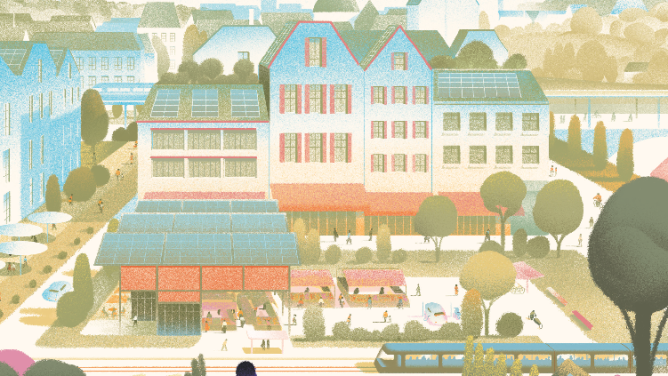These days, “developing biodiversity-friendly cities is thus inextricably linked to sustainable urban development and human wellbeing.” This assessment appeared in the latest (and prolific) edition of the Sustainability journal, which inspired the three chosen examples. It reminds us that conserving urban biodiversity is not only a matter of protecting the environment, but also about creating a more balanced habitat. Some ecologists are preparing the ground for this transition with, for example, the arduous aim of putting in place “geographical, landscape and environmental assessments before coming up with the first blue print for urban planning”. This is far from making a clean break with urban constructions, but rather a question of re-designing, preserving and also having the capacity to evaluate.
Berlin: a new model for measuring “biotic relationships”
Ecologists talk about “biotic” factors to evoke the impact of a living organism on another living organism. Measuring these factors is a huge challenge for urban biodiversity policies. It is rather difficult (and also crucial) to know the effects of urbanisation on biodiversity and on the relationships between species within “socio-ecological” urban environments. Berlin is considered as a good model for studying such biotic relationships. The city has a polycentric design and multiple periods of fast growth and decline have resulted in a complex, porous urban landscape that has discontinuity between built-up areas, empty plots and wasteland areas where nature is encroaching naturally and manmade green spaces.
Therefore, it is no coincidence that the German capital is home to the experimental research platform CityScapeLab, one of the world’s biggest and most ambitious platforms on the subject. Aiming to map and predict the impact of urbanisation on biodiversity, the platform focusses its efforts on dry grassland patches in Berlin’s metropolitan landscape. They set up a network of sensors to enable continuous real-time measurement of environmental parameters on-site (temperature, air pressure, humidity, luminosity, UV radiation, particulates, noise, soil moisture content). As well as analysing other data related to urban structure and activity, these sensors will make it possible to deduce flora and fauna behavioural changes in these grassland patches.
These sensors are linked via the IoT protocol LoRaWAN, an open source network of long-range communications. What’s more, the sensors are all powered by solar energy, making them self sufficient. This device is uncommon and fragile, and yet to produce knowledge that is decisive for future urban plans….
London: wild forests, so close yet so far away.
“Take a walk on the wild side….” Where have we heard this before? We tend to forget that forests are developing in many urban areas. They’re increasingly being integrated into urban green infrastructure, which has caused ecologists to hopefully see it as a commitment towards providing environments for many species, including endangered ones. But also, more generally, it’s the opportunity for city-dwellers to have daily contact with nature, a dynamic often considered necessary for promoting our environmental awareness.
The fact remains that urban forests are largely informal ecosystems which develop anarchically and colonise vacant space, post-industrial sites, landfills and other wasteland. Some cities now encourage the “re-wilding” of certain pre-existing green space, along with parks and also (but even more exceptionally) cemeteries. This is the case in Berlin, Bristol and in Greater London – where one of the “Magnificent Seven” can be found. Abney Park landscape garden cemetery is one of the largest local nature reserves. In 2013, a species of fly that is often used as a bioindicator was discovered there. This species is extremely rare in Europe and hadn’t been spotted in the UK for the past 50 years. The symbol of a “relic woodland fauna that has somehow managed to cling on in the heart of London just a few metres away from busy streets.” Far from the apparent rare occurrence of old baroque cemeteries where disorderly vegetation thrives, maintaining and bio-monitoring these islets of semi-wild urban nature appears to be a major challenge. Who would have thought it? The British capital had in any case created a dedicated biodiversity action plan in 2010. It focuses on the capital’s green space policy, training staff in biodiversity management and alerting them to over-sanitation deemed threatening to certain species.
Basel: (re)greening networks, green infrastructure and wildlife corridors
For many years now, habitat corridors have featured on urban biodiversity conservation plans. One example amongst thousands is Saint-Lunaire, France’s“best small town for biodiversity 2019”. Situated on the coast of Brittany, it was awarded the title for implementing an orientation d’aménagement programmée (OAP) plan, or rather, a successful sustainable replanting policy. Aiming the “return of the number of certain species once considered common yet since become dispersed”, this global network within the community makes it possible to consider the city as a balanced global ecosystem.
The initiative may seem modest but it provides an urban planning framework built upon functional tools and offers a coherent and unifying vision. In densely urban areas, this framework may take the shape of a network of corridors making the “biotope city” a possibility, or rather, a natural habitat with the most uniform living conditions possible for its fauna. Basel is a well-known pioneer for its green development in urban policies (as well as the huge tram depot’s roofs. 10% of the depot’s roofing is home to biodiversity reservoirs – although all of its unused flat roofing could also have the same function!). The city is also an innovative model of how to use abandoned elements of its transport infrastructure, particularly disused railway lines and even a huge, reconverted marshalling yard. Researchers in Basel have shown that transport infrastructures, in particularly railroad embankments, are important wildlife corridors. In towns, railway bridges play a major role in connecting two urban environments and are therefore called upon to integrate biodiversity-lead urban planning.
Other model examples in Europe:
– In France: all winning plans from the Capitale française de la biodiversité(French Capital of Diversity) initiative, including the ambitious Saint-Lunaire mentioned earlier in the article. There is also Lyon and its surroundings, which is home to the inspiringly legendary Plan Canopée and leading numerous dedicated measures.
– Elsewhere in Europe: the European Green Capital 2021, Lahti (more than 100,000 residents and situated in the arctic zone), and its “personal carbon trading app”. Also previous winners such as Vitoria-Gasteiz in the Basque Country, which has reduced its water consumption by almost a half in 30 years and put in place an impressive green belt, plus the 2019 winner, Oslo.


